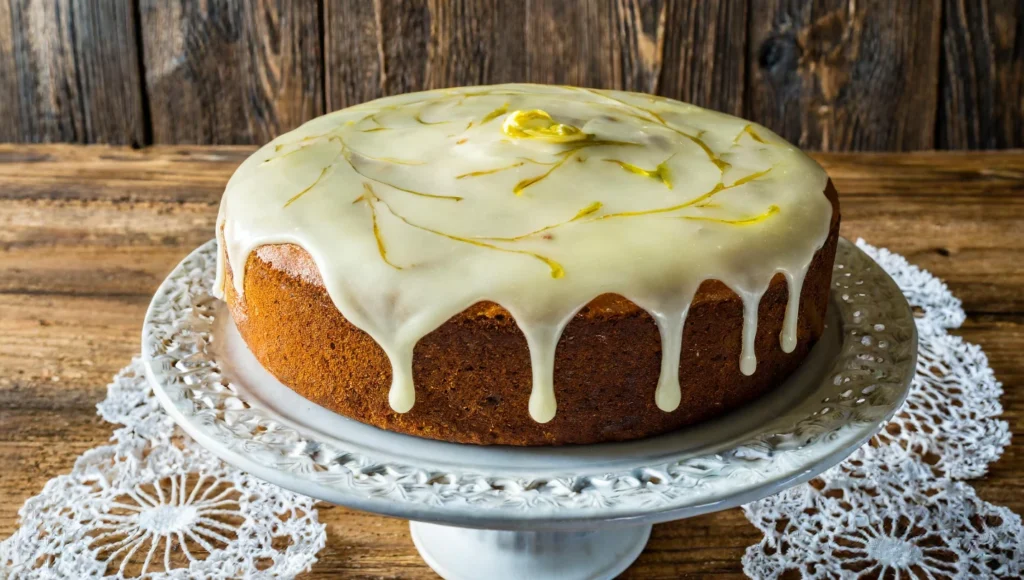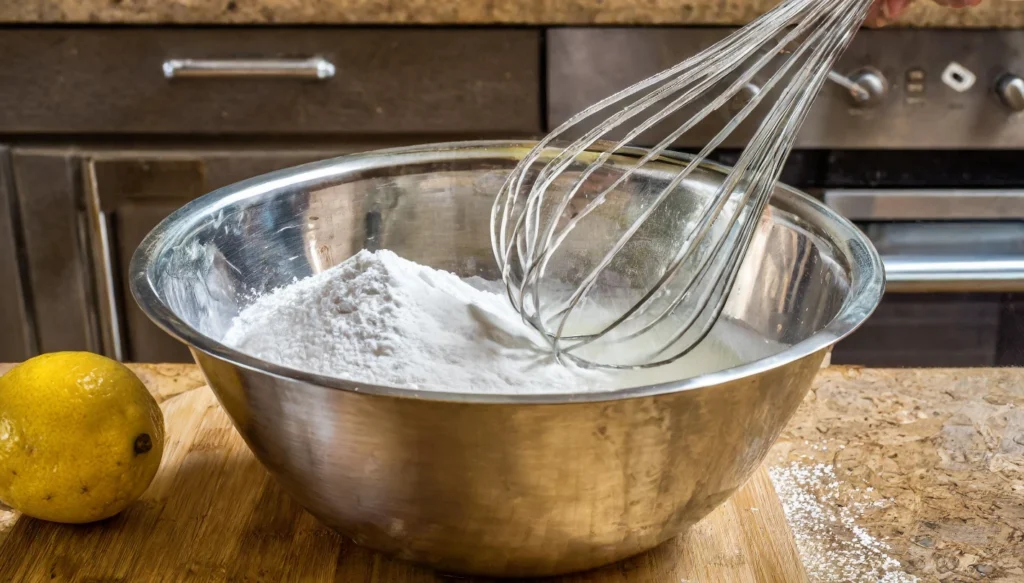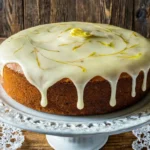
Lemon glaze is a beloved addition to many desserts, offering a perfect balance of sweetness and tanginess that can elevate the simplest baked goods to a new level of deliciousness. But what exactly goes into this delightful concoction? In this comprehensive guide, we’ll explore the ingredients, methods, and variations of lemon glaze, ensuring you have all the knowledge needed to master this versatile topping.
What is Lemon Glaze Made Of?
At its core, What is lemon glaze made of? is a question with a surprisingly simple answer. The basic lemon glaze requires only two ingredients:
- Powdered sugar
- Fresh lemon juice
These components combine to create a smooth, sweet, and tangy glaze that pairs wonderfully with a variety of desserts. For those looking to explore beyond the basics, ingredients like vanilla extract or a pinch of salt can be added to introduce new flavor dimensions.
Importance in Baking
Lemon glaze is more than just an afterthought; it’s a finishing touch that can make all the difference in baking. This simple mixture, capable of transforming ordinary baked goods into extraordinary treats, serves multiple purposes:
- Enhances Flavor: The zesty lemon flavor complements a wide range of desserts, from cakes to cookies.
- Improves Appearance: A drizzle of glaze adds a professional touch to homemade desserts, making them look as good as they taste.
- Adds Texture: Glaze introduces a contrasting soft and smooth texture against the crumbly or fluffy bases it often accompanies.
Discover the joys of lemon-infused desserts like the Lemon Blondies, where the glaze not only adds to the aesthetics but also enhances the moist, tender crumb with a bright lemony kick.
Key Ingredients

The magic of lemon glaze lies in its simplicity, requiring just:
- Powdered Sugar: Also known as confectioner’s sugar, it dissolves easily, offering sweetness and helping the glaze to set with a smooth finish.
- Fresh Lemon Juice: The star ingredient that provides the glaze’s characteristic tartness and thin consistency, making it easy to drizzle.
For those interested in variations, a dash of vanilla or a pinch of salt can round out the flavors, as suggested by Feasting at Home. Experimenting with these additional ingredients can lead to a personalized glaze that perfectly complements your dessert creations.
The Lemon Glaze Recipe
Basic Recipe Overview
Creating a lemon glaze is marvelously straightforward, requiring minimal ingredients and effort. Here’s a brief overview of what you’ll need:
- 1 cup of powdered sugar
- 2 to 3 tablespoons of fresh lemon juice
The simplicity of this recipe makes it accessible for bakers of all levels, from beginners to experts.
Step-by-Step Instructions
To achieve the perfect lemon glaze, follow these detailed steps:
- Combine Ingredients: In a medium mixing bowl, whisk together 1 cup of powdered sugar and 2 tablespoons of fresh lemon juice.
- Adjust Consistency: If the glaze is too thick, add more lemon juice, one teaspoon at a time, until you reach a smooth, pourable consistency.
- Apply the Glaze: Once your baked goods have cooled to room temperature, drizzle or pour the glaze over them. Allow the glaze to set before serving.
This process, while simple, allows for customization in thickness and intensity of flavor, ensuring your desserts are finished to perfection.

Adjusting Thickness and Flavor
The beauty of lemon glaze lies in its versatility. Here are some tips for adjusting its thickness and flavor:
- For a thicker glaze, suitable for spreading, use less lemon juice or add more powdered sugar.
- To intensify the lemon flavor, add a bit of lemon zest to the mix.
- For a thinner glaze, ideal for drizzling, increase the lemon juice.
Experimenting with these adjustments will help you find the perfect balance for your specific dessert.
Applications of Lemon Glaze
Lemon glaze shines when paired with a variety of desserts. Here are some delicious ways to use it:
- Loaf Cakes and Pound Cakes: A classic application that enhances the moist texture of cakes with a zesty finish.
- Scones and Muffins: Add a sweet and tangy kick to breakfast pastries.
- Cookies: Elevate simple cookies with a glossy, flavorful topping.
Incorporating lemon glaze into these desserts not only adds flavor but also a visually appealing finish that makes them irresistible.
Advanced Tips and Tricks
Making the Glaze Without Clumps
Achieving a smooth lemon glaze free of powdered sugar clumps requires a few key techniques:
- Sift the Powdered Sugar: Before mixing, sift the powdered sugar to remove any lumps.
- Whisk Vigorously: Use a whisk to mix the sugar and lemon juice, ensuring a smooth consistency.
- Adjust with Heat: If clumps persist, gently heat the mixture while whisking until smooth.
Storing and Reusing Lemon Glaze
Lemon glaze can be stored and reused with proper handling:
- Storage: Keep in an airtight container in the refrigerator for up to a week.
- Reusing: To reuse, gently warm the glaze until it reaches a pourable consistency. Avoid overheating to prevent thinning.
Enhancing Your Lemon Glaze
Variations of Lemon Glaze
To customize your lemon glaze, consider these variations:
- Add Flavorings: Incorporate vanilla extract, almond extract, or a pinch of salt to add depth to the flavor.
- Use Different Citrus: Substitute lemon juice with lime, orange, or grapefruit juice for a different citrus profile.
Combining Flavors
Lemon glaze pairs wonderfully with other flavors. Experiment by adding:
- Herbs: A hint of thyme or rosemary can introduce a subtle, aromatic quality.
- Berries: Mix in berry purees for a fruity, colorful glaze.
FAQs
Let’s address some frequently asked questions about lemon glaze:
- Can I make lemon glaze without powdered sugar? Yes, granulated sugar can be used, but it should be processed in a blender until fine to avoid grittiness.
- How do I fix a glaze that’s too thin or too thick? Add more powdered sugar to thicken or lemon juice to thin the glaze until the desired consistency is reached.
- Can lemon glaze be frozen? It’s best to avoid freezing as it can affect the texture. Instead, store in the refrigerator and warm slightly before use.
- How long does lemon glaze last? When stored properly in the refrigerator, lemon glaze can last up to one week.
Conclusion
With these advanced tips, tricks, and variations, you’re now equipped to master the art of making lemon glaze. Whether you’re drizzling it over scones, cakes, or cookies, lemon glaze is a simple yet impactful way to add a touch of sweetness and zest to your baked goods. Remember, the key to perfect glaze is experimentation and customization to suit your taste preferences.
By exploring different ingredients and techniques, you can transform your desserts into visually stunning and delicious treats that are sure to impress. Don’t forget to visit the “Blueberry Glaze” for a berry twist and try “Jello Pudding Pie” as a perfect canvas for your newly perfected lemon glaze.

Mastering Lemon Glaze: Ingredients & Tips | Recipe Guide
- Total Time: 5 minutes
- Yield: 1 cup 1x
Description
Step 1: Sift the Powdered Sugar
Sift your powdered sugar into the medium mixing bowl. This step is optional but helps prevent clumps in your glaze, ensuring a smooth consistency.
Step 2: Add Lemon Juice
Add 2 tablespoons of fresh lemon juice to the sifted powdered sugar. If you desire a thinner consistency, you’re welcome to add more lemon juice later on.
Step 3: Whisk Together
Whisk the mixture vigorously until fully combined. Ensure that there are no lumps and the glaze is smooth. If the mixture seems too thick, add more lemon juice, one teaspoon at a time, until you achieve your desired consistency. For a thicker glaze, you can add a bit more powdered sugar until it reaches the thickness you like.
Step 4: Adjust Consistency
Adjust the glaze to your liking. The beauty of lemon glaze lies in its simplicity and adaptability. Whether you prefer a thick glaze to spread with a knife or a thinner one to drizzle with a spoon, you can easily adjust the thickness by playing with the amount of lemon juice.
Step 5: Apply the Glaze
Drizzle or spread the glaze over your cooled baked goods. This is where you get to be creative — use a spoon to drizzle it over cakes, muffins, scones, or cookies, or use a pastry brush for a more even coating. Remember, the baked goods should be at room temperature to prevent the glaze from melting.
Step 6: Let It Set
Allow the glaze to set. After applying the glaze, give it some time to harden slightly on the surface of your desserts. This usually takes about 15-20 minutes at room temperature.
Step 7: Serve and Enjoy
Serve your glazed treats. Once the glaze has set, your desserts are ready to be enjoyed! Lemon glaze adds a lovely zesty flavor and decorative touch to your baking creations.
Ingredients
Ingredients:
1 cup powdered sugar (also known as confectioners’ sugar)
2 to 3 tablespoons fresh lemon juice
Equipment:
Medium mixing bowl
Whisk
Sifter (optional, but recommended for smoother glaze)
Instructions
Sift your powdered sugar into the medium mixing bowl. This step is optional but helps prevent clumps in your glaze, ensuring a smooth consistency.
Add 2 tablespoons of fresh lemon juice to the sifted powdered sugar. If you desire a thinner consistency, you’re welcome to add more lemon juice later on.
Whisk the mixture vigorously until fully combined. Ensure that there are no lumps and the glaze is smooth. If the mixture seems too thick, add more lemon juice, one teaspoon at a time, until you achieve your desired consistency. For a thicker glaze, you can add a bit more powdered sugar until it reaches the thickness you like.
Adjust the glaze to your liking. The beauty of lemon glaze lies in its simplicity and adaptability. Whether you prefer a thick glaze to spread with a knife or a thinner one to drizzle with a spoon, you can easily adjust the thickness by playing with the amount of lemon juice.
Drizzle or spread the glaze over your cooled baked goods. This is where you get to be creative — use a spoon to drizzle it over cakes, muffins, scones, or cookies, or use a pastry brush for a more even coating. Remember, the baked goods should be at room temperature to prevent the glaze from melting.
Allow the glaze to set. After applying the glaze, give it some time to harden slightly on the surface of your desserts. This usually takes about 15-20 minutes at room temperature.
Serve your glazed treats. Once the glaze has set, your desserts are ready to be enjoyed! Lemon glaze adds a lovely zesty flavor and decorative touch to your baking creations.
- Prep Time: 5 minutes
- Cook Time: 0 minutes
- Category: FRUITS
- Method: No Bake
- Cuisine: International
Nutrition
- Serving Size: 2 tablespoons
- Calories: 100 calories
- Sugar: 25 grams
- Sodium: 0 mg
- Fat: 100 calories
- Saturated Fat: 25 grams
- Unsaturated Fat: 0 mg
- Trans Fat: 0 grams
- Carbohydrates: 25 grams
- Fiber: 0 grams
- Protein: 0 grams
- Cholesterol: 0 grams
Keywords: What is lemon glaze made of?, Ingredients in lemon glaze, Lemon glaze recipe components, Making lemon glaze, Lemon glaze essentials
